

Query Language: DROP TABLE. Objective-C : les fondamentaux pour le développement iOS 6. Booktype 1.6.1 : le livre dans tous ses états. How to Install it on Mac OS X - Booktype - Sourcefabric's Wiki. Skip to end of metadataGo to start of metadata Instructions were tested on Mac OS X 10.5, 10.6 and 10.8.
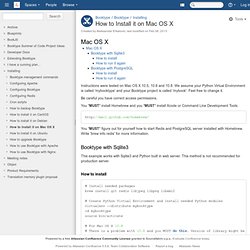
We assume your Python Virtual Environment is called 'mybooktype' and your Booktype project is called 'mybook'. Feel free to change it. Be careful you have correct access permissions. You *MUST* install Homebrew and you *MUST* install Xcode or Command Line Development Tools. You *MUST* figure out for yourself how to start Redis and PostgreSQL server installed with Homebrew.
Booktype with Sqlite3 This example works with Sqlite3 and Python built in web server. How to install How to run it again. Modifier, d'ajouter des extensions de fichiers reconnus. Where the Extensions.txt file contains the list of extensions recognized by Dreamweaver, the MMDocumentTypes.xml file contains information about the server model, color coding style, descriptions, and so forth for each known document type.
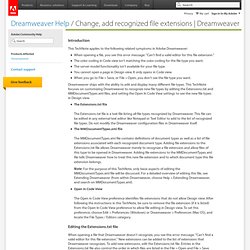
In addition to adding extensions to the Extension.txt file, new extensions must also be added to the file extension lists for the associated document type. If not, Dreamweaver will not know how to display this file type and will open it in Code view by default. If this extension is not associated with any defined document type, a new document type should be created. To create a new document type, see Extending Dreamweaver (from within Dreamweaver, choose Help > Extending Dreamweaver, and search on MMDocumentTypes.xml). Note: For the purpose of this TechNote, 'document type definition' refers to files that contain information about documents recognized by Dreamweaver and are not to be confused by 'DTDs' mentioned in XML documentation. À propos de la mémoire NVRAM et PRAM. Votre Mac stocke certains réglages dans une zone de mémoire spéciale, même lorsqu’il est éteint.

Sur les Mac à processeur Intel, ces réglages sont stockés dans la mémoire NVRAM ; sur les Mac à processeur PowerPC, ils sont enregistrés dans la mémoire PRAM. Les éléments suivants sont notamment stockés dans la mémoire NVRAM et PRAM : How to edit the hosts file in Mac OS X 10.8 – Mountain Lion. The hosts file is a text file that maps hostnames to IP addresses.
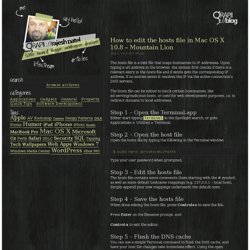
Upon typing a url address in the browser, the system first checks if there is a relevant entry in the hosts file and if exists gets the corresponding IP address. If no entries exists it resolves the IP via the active connection’s DNS servers. The hosts file can be edited to block certain hostsnames, like ad-serving/malicious hosts, or used for web development purposes, i.e. to redirect domains to local addresses. Step 1 – Open the Terminal.app Either start typing Terminal in the Spotlight search, or goto Applications > Utilities > Terminal. Step 2 – Open the host file Open the hosts file by typing the following in the Terminal window: $ sudo nano /private/etc/hosts.
Mac à processeur Intel : réinitialisation du contrôleur de gestion du système (SMC) Dotvoid – A PHP Company. My current web development environment basically consists of a Macbook Pro running Mountain Lion, PHPStorm 5.0 and Virtual Box running one ore more virtual Ubuntu Servers with everything needed.

Correctly setting up a linux guest OS in Virtual Box with shared folders shouldn’t be but is sometimes a bit of a headache. (Even though it does have many advantages.) Others choose not to use virtual servers and instead go for MAMP when using OS X. MAMP is a full local server environment including Apache, PHP and MySQL in one package. Anyone feeling at home in *nix systems should feel at home using both OS X and MAMP. Objective-C Runtime Reference. Class_addIvar Adds a new instance variable to a class.
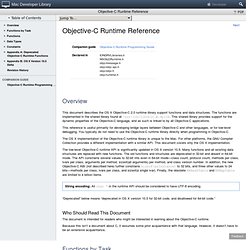
BOOL class_addIvar(Class cls, const char *name, size_t size, uint8_t alignment, const char *types) Return Value YES if the instance variable was added successfully, otherwise NO (for example, the class already contains an instance variable with that name). Discussion. Cocoa - Mac OS X Technology Overview. Cocoa Frameworks The Cocoa frameworks consist of libraries, APIs, and runtimes that form the development layer for all of OS X.
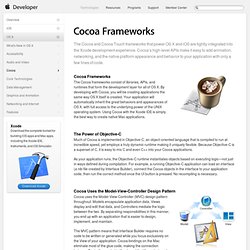
By developing with Cocoa, you will be creating applications the same way OS X itself is created. Your application will automatically inherit the great behaviors and appearances of OS X, with full access to the underlying power of the UNIX operating system. Using Cocoa with the Xcode IDE is simply the best way to create native Mac applications. The Power of Objective-C Much of Cocoa is implemented in Objective-C, an object-oriented language that is compiled to run at incredible speed, yet employs a truly dynamic runtime making it uniquely flexible. As your application runs, the Objective-C runtime instantiates objects based on executing logic—not just in ways defined during compilation. Cocoa Uses the Model-View-Controller Design Pattern Cocoa uses the Model-View-Controller (MVC) design pattern throughout.
Mac Developer Library.